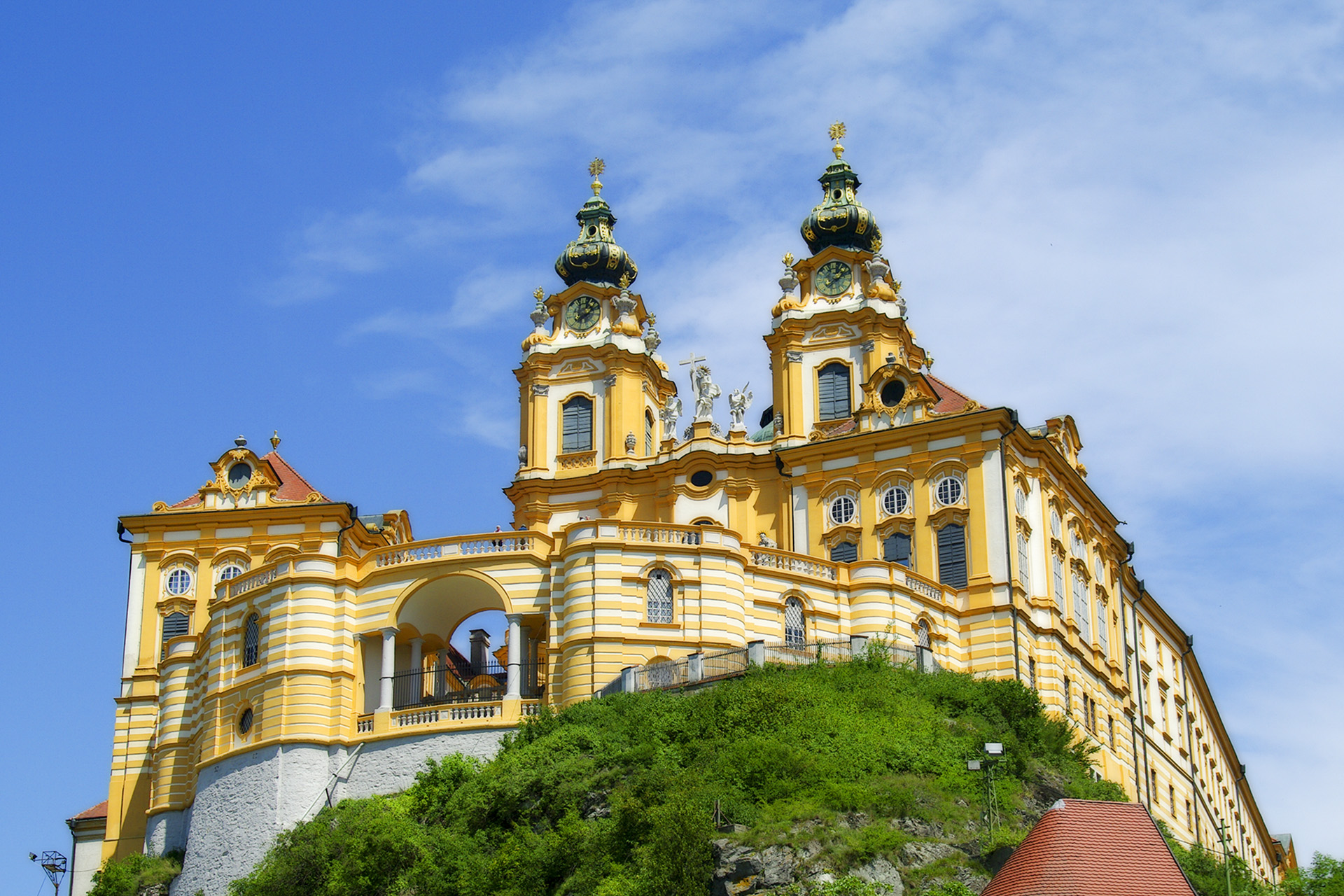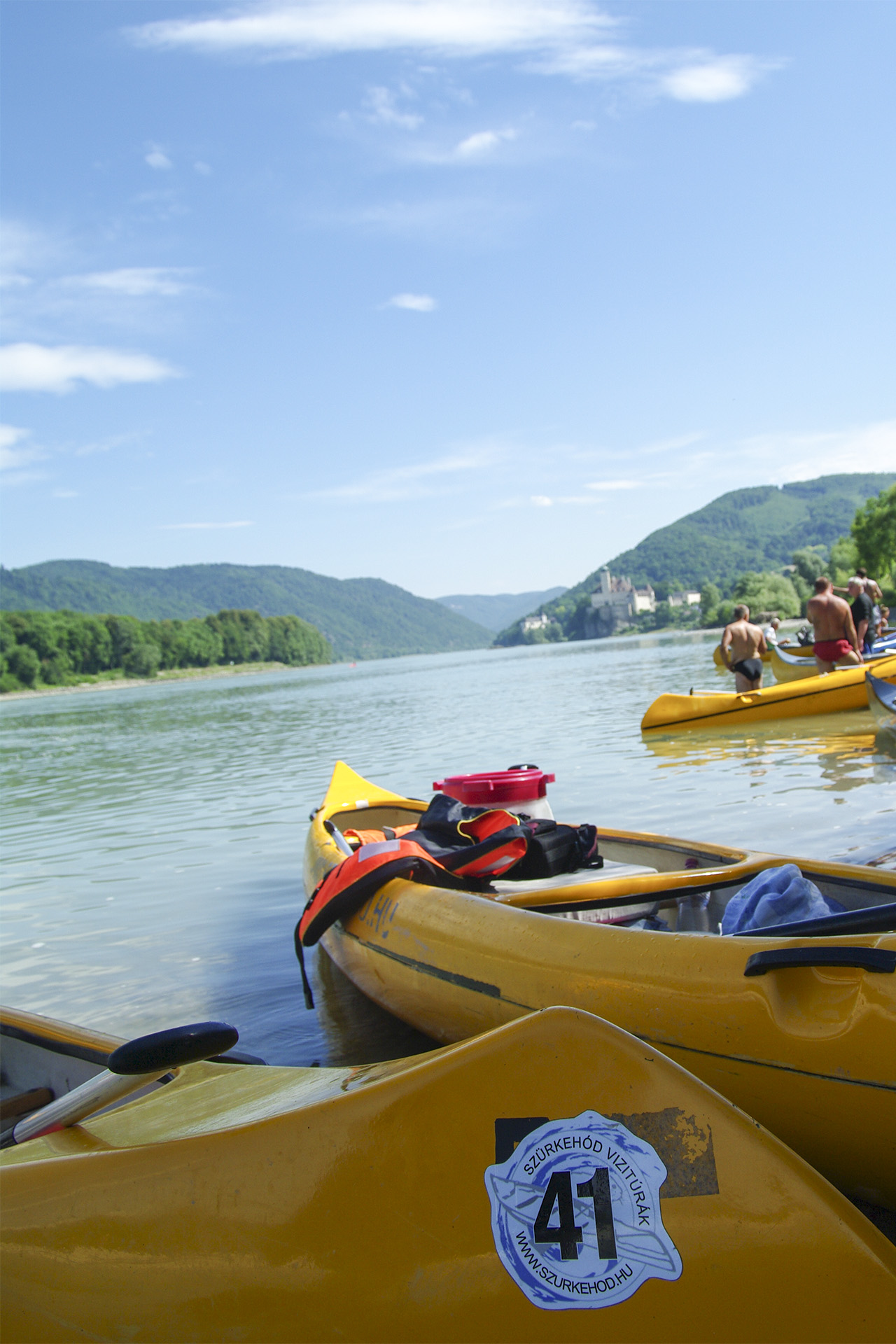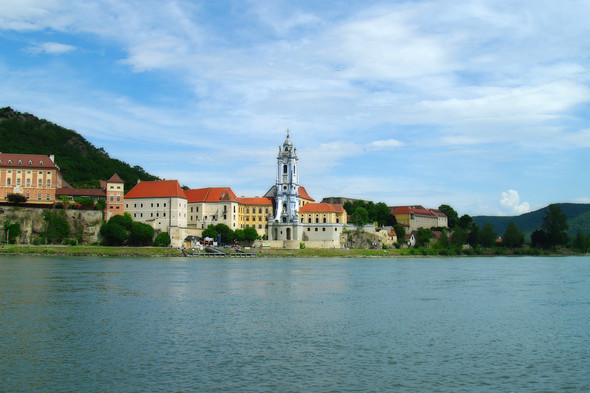We kick off a new event. Our plan is to pay an annual visit to one or two such wineries that are accessible by boat (kayak or canoe). By so doing, we blend two of our passions, paddling and wine, and so coin the novel phrase of “Wine Paddling”. As our first choice, we picked the Austrian Danube, where we embarked on our voyage from Melk to Klosterneuburg. It took us 3 days to complete the journey, which provided us with ample time to paddle as well as to visit the wineries.
While planning a trip there, it is worth leaving a day to visit the abbey of Melk and to stroll along the streets of the city centre before setting off. Next morning, one might set sail early and let the adventure begin! Right after Melk, the most enthralling part of the Danube can be found, where it meanders through the mountains. This is the Austrian Danube bend, the fabled Wachau. Here, the river narrows and so it significantly quickens its pace. One might say that the water “dashes”. For that reason, it is worth being increasingly concentrated on steering while keeping a close watch on the international boat traffic. Passing the vehicular bridge, a perfect, shallow place can be found on the eastern bank of the river that is particularly suitable for landing. This is one of the best places from where a photo can be taken of the marvellous castle of Schönbühel, built upon a cliff right beside the river. Moving on, it is of importance to be on the lookout for the rocks, towering out of the water, thus dividing the river into two distinct parts. Sailing on Paddling on the Danube, while visiting the 4 wine-regions a smaller boat, it is possible to circumvent the rocks from the right thus avoiding the traffic. After that, the western bank of the river offers numerous perfect spots for landing. Later on, passing the castle of Aggstein (on the right), the houses of Willendorf start to outline on the left. From here, it is only about an hour that the monumental Tausendeimeberg emerges in the distance which indicates that we are close to the well-known wine-region of Wachau and a town called Spitz. We move on amid grapes, with steep hillsides, terraces, Green Veltliner and Riesling all around. And the Danube, of course. After a sharp left-turn, Dürnstein and its sky blue church become visible. Another hour has to pass before we could lay eyes on the city of Krems, the place where we stay for the night. The camping can be found on the left side of the river, right after the second Danube Bridge. From the landing stage, the accommodation is just a few steps away.

Attractions: Melk – abbey and the city centre, Aggstein – ruins of the castle, Willendorf – the legendary statue of Venus, Spitz/Weisenkirchen – vineyards and the architectural heritage, Dürnstein – marvellous baroque buildings, the ruins of the castle, the memorial of Richard the Lionheart, Krems – city centre.
Recommended wineries: We visit two wine-regions. We paddled near the Wachau wine region almost until the very end, where there are innumerable famous wineries. Personally, we recommend the Domäne Wachau, because that is the place where visitors get a holistic picture of the land’s wines. However, Krems is the centre of another wine-region called Kremstal. Here the Weingut Stadt Krems is the best choice. Both of the aforementioned wineries are accessible on foot and are just a few minutes away from the bank of the river.
Landing opportunities: In Spitz, the Fohringer wine shop, though it is fairly rocky and the landing is only possible at the steps. In Dürnstein, it is the best to pass the city and land at the local rowing club. From there, the winery and the city centre are at walking distance.
Dining and food: Dining is possible in Spitz as well as in Dürnstein.
Accommodation: In Melk / In Dürnstein – it is possible to camp besides the rowing club if it is discussed with the owners beforehand / In Krems)
In the morning, there will be a more boring route in comparison to that of the previous day’s. Or, at least as for the bank of the river, seeing that there will be no more mountains to be seen. On the eastern bank, there is the abbey of Göttweig, then a few hours later, it is worth taking a break at Traismauer. Here, on the left, there is a spot for landing and right next to it, there is also a restaurant where we can dine or just drink a coffee. An hour later, we reach the journey’s first hydroelectric power plant. Before that, it can be seen miles away that the water gets slower due to the barrage, so it is almost like paddling on a lake. The flooding gate can be found on the western bank where travellers can find a telephone as well. Using this phone, those who intend to use the flooding gate must get in touch with the instructor who gives a full briefing of what to do next. There is no need to worry, sometimes smaller boats go into the cofferdam alongside with monstrous ones. However, inside the dam, there are no waves at all, the boats must not even use their engines there. From here, it is only one and a half hour that we reach our daily destination, the city of Tulln.
Attractions: Tulln – city centre, Egon Schiele museum, the Niebelung fountain.
Landing opportunities: Traismauer – the dock, Zwentendorf – natural sand-bar (on the left), 10 minutes of walking from here, there is a camping to be found, Tulln – the dock in the beginning and at the far end of the city, both on the left. The first one is recommended for sightseeing, while the second’s strength is that it is right next to the camping.
Dining and food: In Traismauer and Tulln.
Accommodation: Zwentendorf / Tulln)
On the final day, it is worth setting off early, seeing that there is still paddling to be done, what is more, at the end of the day we will reach two wine-regions as well. For long, we progress on an ever slowing river, which indicates the fact that we approach another flooding gate. This time, the flood-gate can be found near the right side of the river where, as usual, we have to land and give the instructor a call. After that, the water begins to gather pace and houses appear on the left. This is Korneuburg, where, if we fancy, landing is possible on the western bank, at the rowing club’s dock. The landing point at Klosterneuburg is only a couple of paddles away from there. It is worth being increasingly alert for we can easily miss it. As soon as the first houses appear, one might commence landing. However, be cautious, there are a number of dams which, at high water, might make this spot be dangerous. It is also advisable to arrange the shipping of the boats from here, since paddling through Vienna is not for beginners. Next to the road that leads into the city, there is a camping to be found, from where, the abbey and the winery are both at walking distance.
Attractions: Klosterneuburg – abbey
Landing opportunities: Korneuburg – the dock (left side), Klosterneuburg (on the right)
Accommodation: Klosterneuburg
Wineries: at the wine-region of Wagram, Vienna’s oldest winery, while at the wine-region of Vienna (Europe’s one and only capital where vineyards are to be found within the borders of the city) without doubt, the very best here is Fritz Wieninger, although, his winery is only accessible by car, but it is worth it!)

We brought our boats from Hungary, though, as we see now, it is best to rent one in Vienna and arrange the transportation there too. Those who are in the mood for bringing a good read, we recommend Pall Catt’s unique travelogue, those who fancy reading something more thought-provoking there is Claudio Magris, for the lovers of real literature, there is a Nobel-winning book written by an Austrian writer, the Piano teacher In our related articles, we will give a detailed description of the 4 recommended wineries alongside with all the tasting notes.






